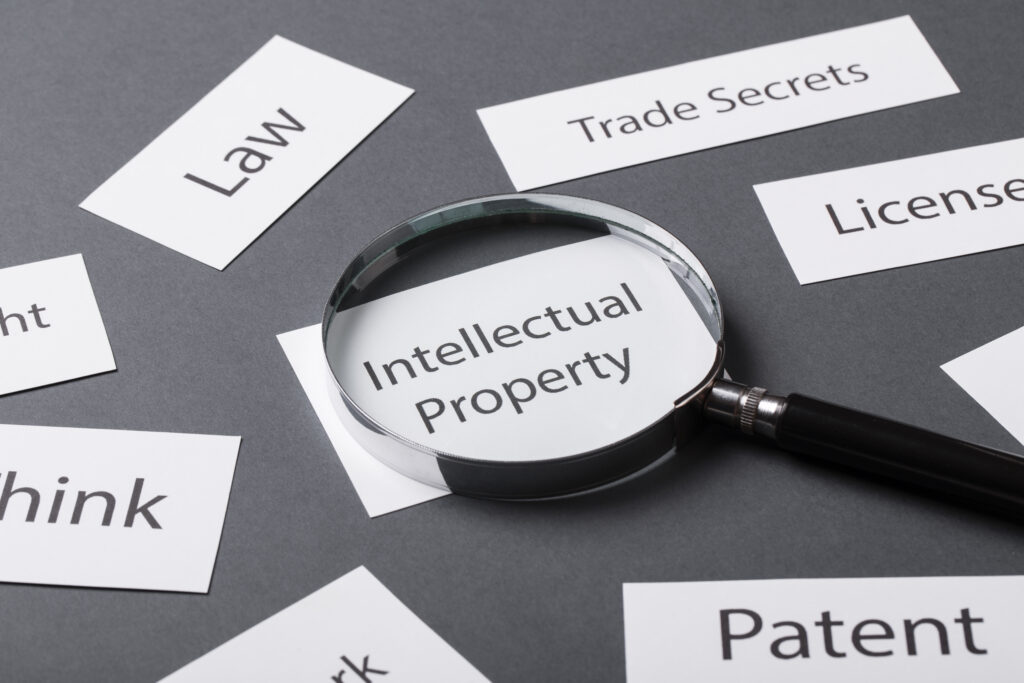Picture this: Your client, a rising fashion brand, is set to launch a new logo. Overnight, your AI tools flag a potential trademark dispute — not because of an identical design, but because the logo’s color scheme and shape evoke a competitor’s mark in a way that could confuse consumers.
A few years ago, identifying such nuanced risks would have relied on subjective judgment and days or weeks of manual checks. Today, AI-powered image and sentiment analysis can instantly compare visual elements and predict market perception, empowering you to advise your client before a costly launch. This isn’t just about efficiency, it’s about unlocking insights into consumer behavior that humans might never anticipate.
The stakes in intellectual property law have never been higher. In the modern global economy, a single patent, trademark, or copyright can be worth billions. Yet IP attorneys face an overwhelming challenge: the sheer volume of patents, trademarks, and copyrights we need to analyze grows exponentially each year. A patent attorney searching for prior art might need to review thousands of patents across multiple countries. A trademark lawyer clearing a new brand name needs to check countless existing marks, not just for exact matches but for similar-sounding names or lookalikes that could cause confusion.
This article explores how artificial intelligence is transforming intellectual property practice and provides practical guidance for attorneys looking to leverage these powerful new tools effectively.
Key Insight: AI doesn’t just make IP work faster. It makes it more thorough, allowing attorneys to discover connections and insights they might otherwise miss entirely.
How AI is Changing Patent Practice
Patent attorneys have traditionally spent countless hours searching through existing patents to determine if an invention is truly new. This process of prior art searching historically relied on keyword searches and manual review of hundreds or even thousands of documents. AI tools are making this process not just more efficient, but more thorough and insightful.
Better Patent Searching
Traditional patent searches rely heavily on exact keyword matches, which can miss relevant patents that use different terminology for the same concepts. For example, when searching for patents related to a new type of coffee maker, a traditional search might look for terms like “coffee maker,” “coffee brewing,” or “coffee preparation.” However, relevant patents might use completely different terms like “beverage extraction system” or “heated liquid dispensing apparatus.”
AI-powered patent search tools work fundamentally differently. They understand the underlying concepts in a patent, not just the specific words used. These systems can:
Understand Technical Concepts
- Recognize similar inventions even when described differently
- Identify related technical approaches across different fields
- Understand relationships between different technologies
- Spot patterns in how inventions solve problems
Analyze Patent Drawings
- Interpret technical drawings and diagrams
- Match similar mechanical structures
- Identify common design elements
- Compare functional relationships between components
Writing and Analyzing Patent Applications
Beyond searching, AI tools are transforming how we write and analyze patent applications. These tools serve as intelligent assistants, helping catch potential issues before they become problems during examination.
Let’s explore how these systems help at each stage of the patent drafting process.
AI tools can analyze your draft patent application to identify potential problems that might lead to rejection. Think of it as having an experienced patent examiner review your application before you file it. The AI looks for common issues that often trigger rejections, such as:
- Missing antecedent basis in claims (using “the widget” before introducing “a widget”)
- Inconsistent terminology throughout the application
- Claims that might be too broad or too narrow based on the specification
- Potential clarity issues that could confuse patent examiners
- Support issues between claims and specification
The AI can also suggest improvements based on successful patents in similar technical fields. These systems can analyze successful patents to recommend:
- More effective ways to describe the invention
- Additional features worth claiming
- Better organization for the patent application
- Stronger arguments for patentability
- More comprehensive claim coverage
See our guide on contracts for an understanding on how similar AI similar algorithms and processes are used in contract drafting and analysis.
How AI Revolutionizes Trademark Practice
Trademark practice presents unique challenges that AI is particularly well-suited to address.
When a client wants to use a new brand name, we need to search for existing trademarks that might block its use. This isn’t just about finding exact matches, it’s about understanding how consumers might perceive and potentially confuse different brands.
Advanced Trademark Searching
Traditional trademark searches often miss potential conflicts because they focus primarily on exact matches or simple variations. Modern AI-powered trademark search tools understand language and branding at a much deeper level. Here’s how they work:
The AI analyzes proposed trademarks across multiple dimensions:
Linguistic Analysis
The system examines:
- Similar spellings and misspellings
- Phonetic similarities (how marks sound when spoken)
- Semantic relationships (words with similar meanings)
- Translation and transliteration variations
- Regional language differences
Visual Analysis
For logos and design marks, AI uses advanced image recognition to analyze:
- Overall composition and layout
- Specific graphic elements
- Style and artistic treatment
- Color combinations and patterns
- Visual impression and impact
Understanding Market Impact
One of AI’s most valuable contributions to trademark practice is its ability to analyze how consumers actually perceive and interact with brands in the real world. These tools can:
Analyze Social Media and Online Content
- Track how consumers discuss similar brands
- Identify common misspellings or variations
- Spot instances of actual confusion
- Monitor brand recognition patterns
- Assess market impact and reach
Consider Cultural and Language Differences
The AI examines potential issues across different markets:
- Words with different meanings in other languages
- Cultural associations that might affect perception
- Regional variations in language use
- Translation and transliteration challenges
- Local market considerations and customs
These AI technologies and processes should also be a part of due diligence and compliance checks for vetting IP rights and restrictions.
How AI Transforms Copyright Practice
In today’s digital world, copyright attorneys face unprecedented challenges. Every minute, thousands of new works are created and shared online — from articles and images to software code and creative content. Monitoring this vast landscape for potential infringement while managing large portfolios of copyrighted works would be impossible without artificial intelligence tools.
Finding Copyright Infringement
Think of trying to find a single copied photograph among millions of images posted online each day. Now imagine that the photo has been slightly modified — cropped differently, filtered, or combined with other images. Traditional copyright monitoring tools would likely miss these modified copies, but AI systems can spot them by understanding the fundamental characteristics that make each work unique.
Modern AI copyright tools work by analyzing content at multiple levels:
Surface Characteristics
The AI examines obvious features like:
- Exact matches in text or code
- Direct copies of images or audio
- Identical file structures
- Basic pattern matching
- Simple modifications
Deep Structure Analysis
More importantly, the AI understands:
- The underlying organization of content
- Characteristic patterns in creative works
- Stylistic elements and signatures
- Fundamental relationships between elements
- Core creative expressions
For example, when analyzing music for potential copyright infringement, AI tools don’t just look for identical recordings. They can identify:
- Similar melodies in different keys or tempos
- The same music with different arrangements
- Samples or clips used in new compositions
- Characteristic chord progressions
- Distinctive rhythmic patterns
Managing Software Copyright
Software presents unique copyright challenges because code can be copied and modified in countless ways while still performing the same function. Modern AI tools help attorneys analyze software by understanding both its structure and function.
When examining software for potential copyright infringement, AI tools analyze:
Code Structure
The system examines how the software is organized:
- The overall architecture
- Function and class relationships
- Implementation patterns
- Data structures
- Control flow
Functional Analysis
Beyond just looking at the code itself, AI examines:
- How the software operates
- What problems it solves
- Its interaction patterns
- Performance characteristics
- User interface elements
Managing Large Copyright Portfolios
Many organizations own thousands or even millions of copyrighted works. Managing these vast portfolios effectively requires understanding not just what you own, but how those assets are being used and what they’re worth.
AI tools help attorneys handle this complexity by:
Tracking Usage and Value
The AI continuously monitors:
- Where and how works are being used
- Licensing opportunities and violations
- Market value and trends
- Revenue generation potential
- Strategic importance
Managing Legal Requirements
These systems also help maintain legal protection by:
- Monitoring registration status
- Tracking renewal deadlines
- Identifying jurisdictional requirements
- Managing documentation
- Ensuring compliance
Strategic IP Planning with AI
Imagine trying to play chess while only being able to see one square at a time. That’s similar to how organizations approached business law problems like IP strategy before AI tools became available. Today, artificial intelligence gives us a comprehensive view of the entire IP landscape, allowing us to make more informed strategic decisions for our clients.
Understanding Technology Landscapes
To develop effective IP strategies, we need to understand not just where technology is today, but where it’s heading. AI systems help create this understanding by analyzing patterns in patent filings, scientific publications, and market activities across the globe.
Consider the development of electric vehicle technology. An AI system might reveal that while major automotive companies are filing many patents related to battery technology, smaller companies are focusing heavily on charging infrastructure patents. This insight could help your client decide where to focus their R&D efforts and IP investments.
The AI examines multiple data sources to build a complete picture:
Patent Filing Patterns
The system analyzes worldwide patent applications to identify:
- Which technologies are seeing increased patent activity
- Where different companies are focusing their efforts
- How technical approaches are evolving
- Which markets are becoming more important
- What new combinations of technologies are emerging
Market and Business Intelligence
Beyond patent data, the AI examines:
- Company investments and acquisitions
- Research and development spending
- Product launches and announcements
- Technical standards development
- Market trend indicators
Monetization and Licensing Strategy
One of the most valuable applications of AI in IP strategy is identifying and evaluating licensing opportunities. Traditional methods often missed potential licensing deals because it was impossible to manually track all possible partners and opportunities. AI tools transform this process by providing a systematic approach to finding and evaluating licensing opportunities.
The AI helps attorneys identify potential licensees by analyzing:
Technical Alignment
The system looks for companies that:
- Work in related technical areas
- Have complementary technology needs
- Are entering new markets where they need IP rights
- Show interest in similar technologies
- Might benefit from cross-licensing arrangements
Business Fit
Beyond technical matching, the AI evaluates:
- Market position and strategy
- Financial capabilities
- Geographic presence
- Industry relationships
- Strategic goals
Building Strategic Patent Portfolios
When building patent portfolios, organizations need to balance multiple factors: technical coverage, geographic protection, cost, and strategic value. AI tools help attorneys optimize these decisions by providing deeper insights into portfolio structure and value.
Consider how AI helps with portfolio development:
Coverage Analysis
The system examines existing patents to identify:
- Technical areas needing additional protection
- Gaps in geographic coverage
- Potential vulnerability to competitors
- Opportunities for strategic blocking patents
- Areas where protection might be unnecessarily duplicative
Filing Strategy Optimization
Based on this analysis, AI tools help determine:
- Which inventions to patent first
- Where to file patent applications
- When to use different types of applications
- How to structure patent families
- Which claims to pursue in different jurisdictions
Implementing AI in IP Law
Successfully integrating AI tools into your intellectual property practice requires more than just purchasing software. It requires careful planning, thoughtful implementation, and ongoing attention to quality control. Let’s examine how to approach this transformation effectively.
Starting Your AI Journey
Think of implementing AI like adding a new associate to your practice — one with extraordinary capabilities but also specific limitations. Just as you wouldn’t expect a new associate to handle complex matters without supervision, you shouldn’t expect AI tools to operate autonomously. The key is to start small and build confidence gradually.
Begin by identifying specific tasks where AI can provide immediate value:
Understanding Your Current Process
Before implementing any AI tools, document how you currently handle:
- Patent and trademark searches
- Portfolio management tasks
- Document drafting and review
- Client reporting and communication
- Competitive monitoring
This baseline understanding helps you measure improvements and identify where AI can have the greatest impact.
Setting Clear Goals
Define specific objectives for your AI implementation:
- Which tasks do you want to automate or enhance?
- What efficiency improvements do you expect?
- How will you measure success?
- What quality standards must be maintained?
- How will you train staff to use the new tools?
Ensuring Quality Control
Quality control becomes even more critical when using AI tools. The goal is to leverage AI’s capabilities while maintaining professional standards and judgment. Here’s how to approach quality control systematically:
Verification Protocols
Establish clear procedures for verifying AI outputs:
- Regular spot-checking of search results
- Comparison with traditional methods
- Documentation of verification steps
- Clear error reporting procedures
- Regular accuracy assessments
Training and Supervision
Develop comprehensive training programs that cover:
- Basic AI concepts and capabilities
- Tool-specific training
- Quality control procedures
- Error recognition and reporting
- Professional responsibility considerations
Measuring Success and ROI
Understanding the return on your AI investment requires tracking both quantitative and qualitative metrics. Here’s how to develop a comprehensive measurement framework:
Efficiency Metrics
Track improvements in:
- Time spent on routine tasks
- Search comprehensiveness
- Analysis depth
- Response time to client requests
- Resource allocation
Quality Indicators
Monitor changes in:
- Error rates
- Client satisfaction
- Work product consistency
- Risk management effectiveness
- Strategic insight generation
Conclusion
The integration of artificial intelligence into intellectual property practice represents more than just a technological upgrade. It’s a fundamental transformation in how we approach IP law. AI tools are helping us work more efficiently, think more strategically, and provide better service to our clients.
However, successful implementation requires a balanced approach. While AI can dramatically improve efficiency and insight, it must be implemented thoughtfully, with appropriate quality controls and ongoing supervision. The most successful practices will be those that leverage AI’s capabilities while maintaining strong professional judgment and high ethical standards.
As AI technology continues to evolve, staying informed about new capabilities and best practices becomes increasingly important. Regular training and updates on AI capabilities will help ensure your practice remains competitive and effective.
Frequently Asked Questions
Q. How much technical expertise do attorneys need to effectively use AI tools in IP practice?
A. While basic familiarity with AI concepts helps, most modern IP-focused AI tools are designed for legal professionals, not technical experts. The key is understanding the tools’ capabilities and limitations rather than their technical details. You’ll want to focus on learning how the tools apply to your specific practice area rather than mastering the underlying technology.
Q. How can small IP practices compete with larger firms in implementing AI?
A. Many AI tools are now available on a subscription basis, making them accessible to practices of all sizes. Small firms can often implement AI more quickly and flexibly than larger organizations. Focus on specific high-value applications rather than trying to transform everything at once, and consider starting with general-purpose AI tools that can be applied across multiple practice areas.
Q. What are the biggest risks when implementing AI in IP practice?
A. he main risks include over-reliance on AI without appropriate verification, inadequate training and quality control, and potential confidentiality issues. Proper implementation protocols and regular auditing help mitigate these risks. Remember that AI is an assistant, not a replacement for your professional judgment.
Q. How long does it typically take to see ROI from AI implementation?
A. Most practices report seeing positive ROI within 6-12 months of implementation, primarily through efficiency gains and expanded capabilities. However, this depends on careful planning and systematic implementation. Start by measuring your current processes to establish a baseline, then track improvements as you implement AI tools.
Q. How should firms handle client questions about AI use in their matters?
A. Be transparent about AI use while emphasizing that it enhances rather than replaces attorney judgment. Many clients appreciate the efficiency and thoroughness AI tools provide when properly implemented. Consider developing a simple explanation of how you use AI to benefit clients, focusing on improved quality, speed, and cost-effectiveness.
Q. Can AI tools help with international IP matters?
A. Yes, AI tools are particularly valuable for international IP work. They can analyze patents and trademarks across multiple jurisdictions, understand documents in different languages, and identify regional filing patterns. This global perspective helps develop more effective international IP strategies and reduces the risk of missing important information.
Q. How do you ensure confidentiality when using AI tools?
A. Look for AI tools specifically designed for legal work with appropriate security features. Review vendor security protocols, data storage practices, and confidentiality agreements. Some firms prefer on-premises solutions for highly sensitive matters. Always verify that any AI tool you use meets your ethical obligations for client confidentiality.
Q. What types of IP tasks should not be delegated to AI?
A. While AI can assist with many tasks, it shouldn’t make final strategic decisions, determine legal positions, or handle client communications without supervision. Complex negotiations, nuanced ethical decisions, and matters requiring significant creative thinking should remain primarily human-driven, with AI in a supporting role.
Q. How can you stay current with rapidly evolving AI capabilities?
A. Dedicate time for regular learning about new AI developments. Join professional groups focused on legal technology, attend relevant CLE programs, follow thought leaders in legal AI, and set aside time to experiment with new tools and features. Consider designating an “AI champion” in your practice to track developments and share insights.





